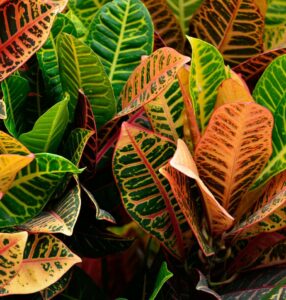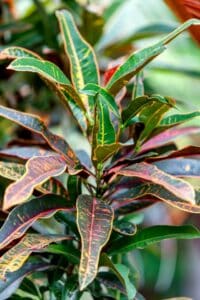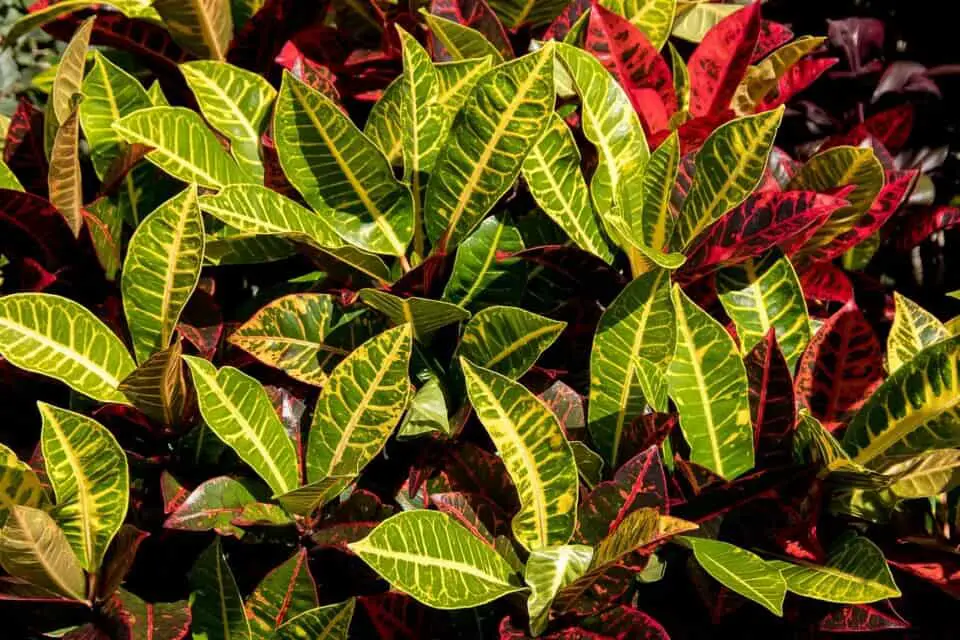Some links in the post are affiliate links and I get a commission from purchases made through some links found in the post.
Crotons are also known as Variegated Laurel and Codiaeum Variegatum. They originate from Indonesia and India and became popular in the mid-twenties.
Crotons have many varieties. All varieties vary in color range, size, growth, and tolerance rate.
Crotons have many color foundations such as red, yellow, orange, bright green, purple, pink, and many other shades.
Some varieties of croton (Codiaeum Variegatum) have only one color and other varieties have a mixture of five to six colors.
But sometimes, you may notice that your croton is turning green. This happens due to many reasons.
A croton may be turning green due to insufficient amounts of light, over-fertilizing, high temperature, and low humidity. Crotons have a low tolerance for high temperatures.
But before we head straight to resolve the dispute of crotons turning green, you need to understand the mechanism of crotons (Codiaeum Variegatum).
For young crotons turning green is normal. Crotons do turn green before they start showing their original colors. If you have bought young crotons, you need to study the plant closely.
It will change the colors gradually. But if your mature croton is turning green then you need to check all the necessary elements to recover the colors of your croton.
Apart from this, certain varieties of croton have only green or mixture or green-yellow colors.
The Superstar Croton/Codiaeum Variegatum Pictum has bright green foliage with small spots of yellow color.
Likewise, Codiaeum variegatum Sunny Star, Codiaeum variegatum ‘Eleanor Roosevelt’ and many others have only green color foliage.
If you have crotons (Codiaeum Variegatum) full of multi-colors and it changes to green, then you need to go through the whole process to retain the original colors.
Primarily, there are three reasons which could be the grounds of your croton turning green. Here, we will discuss each of the elements in detail.
So, without any further due, let’s resolve the croton turning green dispute.
Why is your Croton Turning Green?
 Croton (Codiaeum Variegatum) with its multi-color foliage gives a compliment to your interior décor. It has many colors comprising orange, pink, bright yellow, and green.
Croton (Codiaeum Variegatum) with its multi-color foliage gives a compliment to your interior décor. It has many colors comprising orange, pink, bright yellow, and green.
It has a special color combination of yellow and green. Orange, pink, and yellow colors are always mingled with a green color.
The green color on a croton is bright soft green. The color is not either a neon green nor a dark blackish green color.
If you observe the dark blackish green color in your croton, then it means that your plant has not been receiving the right amount of light, water, and many other things for a long time.
In this case, you need to study your crotons in detail to recuperate the miraculous colors of your plant.
So, why is your croton turning green? The primary reason that your croton is losing its color and turning green is an inefficient amount of light.
1) Inefficient Amount of Light
Light portrays an expressive role in maintaining the colorful foliage of crotons. Light upholds the photosynthesis process as well as the control of the role of pigmentation.
If your crotons are not receiving enough light, it will distort the foliage of the plant.
Now, is there any way we could stop your croton from turning green? Yes! All you need is bright indirect light or dappled sun.
The direct sunlight will show a negative response to your crotons. In this case, you need to study the complete guide of light for your crotons.
Crotons (Codiaeum Variegatum) thrive entirely in dappled sun or bright indirect light. If you’re planting crotons outside then you need to find a position where your plant has access to the dappled sun.
Dappled sun means that you filter the light by using big trees’ branches or leaves. Under the dappled sun, crotons will thrive flawlessly and also maintain the colorful foliage.
The green color will take time to convert into the original color of the plant (orange, red, pink, yellow, purple, etc).
It is also true that crotons easily thrive in partial shade. In partial shade, the internal mechanism of the crotons will perform precisely but there are chances that the plant might lose its original color and you will observe the dark green color in your crotons.
So chose the right spot for crotons for colorful foliage.
In case you are settling the crotons indoors then you need to locate the spot where your plant has contact with the bright indirect light.
It is favorable to set your plant near a south-facing window. But if you are living in a high-temperature area then relocate the position of the plant. It is recommended to use a curtain or any other type of filter to protect your plant.
If you need more on getting the right light for your croton, check our our light requirements for a croton.
2) Over-fertilizing
Over-fertilizing is another possibility for your croton turning green. When you add too much fertilizer to your croton, it can cause more harm than good.
Firstly, it will rot the roots of the plant. This will stop the plant being able to take up water water and cause a lack of fluids getting to your plant.
As a result, the plant will be traumatized and start losing its color, and two to three days later, you will observe only green foliage.
Now, how to recognize that your croton turning green is caused by the over-fertilizing, not because of an inefficient amount of light.
Simply, if you observe green foliage, as well as the soil, is getting dry out within two to three days then it means it is caused by over-fertilizing.
(It happens rarely that people over-fertilize, most of the time it is caused by the inefficient amount of light)
Now, how to fix this problem. The best way to recover your plant is repotting.
It is favorable to slide out the rotten roots and provide a new stable environment to the crotons. Try to add water frequently (when you observe the soil getting dry out) and give the right temperature to the plant.
3) Cold Draft or Overwintering
 If you are living in an area where the temperature drops below 50-degree Fahrenheit in the winters, then it will be affecting the colors of your croton.
If you are living in an area where the temperature drops below 50-degree Fahrenheit in the winters, then it will be affecting the colors of your croton.
Crotons like warm and cozy temperatures around 68° to 77°F and humidity levels between 40% to 50%. This is the ideal condition for crotons to maintain their colorful foliage.
In the winter season, there are high chances of frost bites and discoloration.
In case your crotons are turning green in the winter, then you should relocate your plant. Put your outdoor crotons inside and keep the temperature above 50 Fahrenheit.
Is your indoor croton turning green? Then you need to check three things: temperature, humidity level, and water concentration.
If the temperature is set according to the needs of the plant then you need to focus on the level of humidity. Crotons like to thrive in normal to little high humidity.
In this case, it is favorable to use a humidifier to recover the colors.
In winters, it is recommended to give water once a fortnight but you can mist your plant whenever you observe the dryness over your leaves. But do not mist your plant too much in winters.
You may also like: Why are my croton leaves drooping
4) Pest Infection
The last reason for croton could be turning green could be a pest infection. It is very easy for pests to attract the crotons and affect them.
Pest usually attacks the croton’s stems and grasps out all the nutrients. In this way, crotons become fragile and start losing their original color.
The best way to mend your croton’s color is to use spray and make your crotons clear from the pest.
Final Thoughts
Due to its aesthetic and alluring color scheme of leaves, it is considered the best non-flowering houseplant.
Apart from their beauty, crotons are also known in the medical industry, oil is extracted from them. They only tend to live for about 4 years and are perennials.
A warning about owning a croton is that they contain toxic chemicals which are harmful to cats and humans. If you have cats or children in your home then there are chances that they might try to eat them so keep them out of reach.
But crotons don’t cause severe dermatitis in cats or humans. It only shows a mild reaction but it must be treated.

